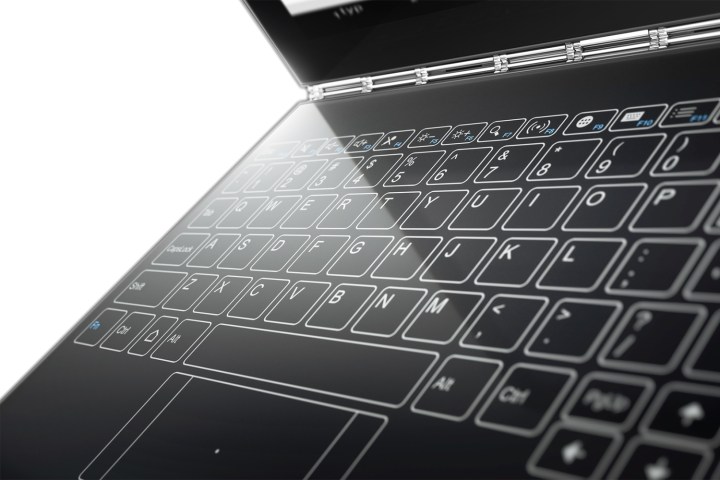
As previously reported, the Yoga Book’s halo keyboard also serves as a writing platform for the Yoga Book’s included stylus. This accessory packs real ink, enabling users to throw a piece of paper on the touch surface and draw or write. This results in the production of physical and digital versions simultaneously. The touch surface actually includes a special film specifically created by professional pen tablet maker Wacom for real-time, hand-based digital input, like drawing and cursive writing.
“The real-pen accessory can draw with the precision of a pencil or paintbrush, with 2,048 pressure levels and 100-degree angle detection,” the company said during the show. “In addition, you’ll never have to charge or replace it — the real-pen accessory doesn’t require batteries and its ink can be replaced with standard ink tips, just like that of a conventional pen.”
Another notable feature is the Yoga Book’s special hinge combining the tablet portion with the touch surface. This hinge is a combination of magnesium and aluminum alloys weaved together in a watchband-style design. Thus, the hinge is capable of transitioning the Yoga Book between four positions: browse, watch, create, and type. Although the touch surface and display bezel are dark in color, the hinge and outside shell are offered in Champagne Gold or Gunmetal Grey for the Android model, and Carbon Black for the Windows 10 Home model.
On the Android front, the Yoga Book is based on version 6.0 “Marshmallow” of Google’s operating system. However, Lenovo seems to have altered the platform a bit to create Book UI, an interface that combines the best features of laptops and tablets. Book UI provides an Android-based desktop experience complete with a taskbar and the ability to run multiple apps simultaneously on the screen. The platform even supports keyboard shortcuts and action keys.
Overall, there are three Yoga Book models to choose from: the two Android versions for $500 and the one Windows 10 Home version for $550. On the hardware front, all three sport the same components, as shown below. The three Yoga Book units are expected to be available at retail stores in the U.S. by the end of October.
- Processor: Intel Atom x5-Z8550 (quad-core, up to 2.4GHz)
- Display: 10.1-inch IPS LED-Lit LCD with Touch
- Resolution: 1,920 x 1,200
- Color Depth: 16.7 million
- Color Gamut: 70 percent
- Brightness: 400 nits
- Memory: 4GB LPDDR3
- Storage: 64GB
- Networking: Wireless AC
- Bluetooth: Version 4.0
- Sound: Dolby Audio Premium
- Card Slot: microSD supporting up to 128GB
- Battery: Li-ion Polymer 8,500 mAh
- Battery Usage: Over 70 days standby, 13 hours general
- Camera: 8MP rear, 2MP front
Editors' Recommendations
- The Lenovo Yoga Book 9i is the Surface Neo I always wanted
- F(x)tec Pro 1, the phone with a full-size keyboard, is available for pre-order


